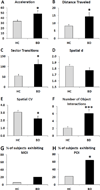Inhibitory deficits in euthymic bipolar disorder patients assessed in the human behavioral pattern monitor
- PMID: 23759280
- PMCID: PMC3759601
- DOI: 10.1016/j.jad.2013.05.020
Inhibitory deficits in euthymic bipolar disorder patients assessed in the human behavioral pattern monitor
Abstract
Background: Bipolar disorder (BD) is associated with inhibitory deficits characterized by a reduced ability to control inappropriate actions or thoughts. While aspects of inhibition such as exaggerated novelty-seeking and perseveration are quantified in rodent exploration of novel environments, similar models are rarely applied in humans. The human Behavioral Pattern Monitor (hBPM), a cross-species exploratory paradigm, has identified a pattern of impaired inhibitory function in manic BD participants, but this phenotype has not been examined across different BD phases. The objective of this study was to determine if euthymic BD individuals demonstrate inhibitory deficits in the hBPM, supporting disinhibition as an endophenotype for the disorder.
Methods: 25 euthymic BD outpatients and 51 healthy comparison subjects were assessed in the hBPM, where activity was recorded by a concealed videocamera and an ambulatory monitoring sensor.
Results: Euthymic BD individuals, similar to manic subjects, demonstrated increased motor activity, greater interaction with novel objects, and more frequent perseverative behavior relative to comparison participants. The quantity of locomotion was also reduced in BD individuals treated with mood stabilizers compared to other patients.
Limitations: Low sample size for treatment subgroups limits the evaluation of specific medication regimens.
Conclusions: Our results suggest that BD is distinguished by both trait- and state-dependent inhibitory deficits optimally assessed with sophisticated multivariate measures. These data support the use of the hBPM as a tool to elucidate the effects of BD across various illness states, facilitate the development of BD animal models, and advance our understanding of the neurobiology underlying the disorder.
Keywords: Behavioral pattern monitor; Bipolar disorder; Euthymic; Exploration; Impulsivity; Inhibition.
© 2013 Elsevier B.V. All rights reserved.
Figures


References
-
- Akiskal HS, Benazzi F. Toward a clinical delineation of dysphoric hypomania - operational and conceptual dilemmas. Bipolar Disorders. 2005;7:456–464. - PubMed
-
- Altshuler LL, Ventura J, van Gorp WG, Green MF, Theberge DC, Mintz J. Neurocognitive function in clinically stable men with bipolar I disorder or schizophrenia and normal control subjects. Biological Psychiatry. 2004;56:560–569. - PubMed
-
- Anand A, Barkay G, Dzemidzic M, Albrecht D, Karne H, Zheng QH, Hutchins GD, Normandin MD, Yoder KK. Striatal dopamine transporter availability in unmedicated bipolar disorder. Bipolar Disorders. 2011;13:406–413. - PubMed
-
- Berk M, Ng F, Wang WV, Calabrese JR, Mitchell PB, Malhi GS, Tohen1 M. The empirical redefinition of the psychometric criteria for remission in bipolar disorder. Journal of Affective Disorders. 2008;106:153–158. - PubMed
-
- Bora E, Yucel M, Pantelis C. Cognitive endophenotypes of bipolar disorder: a meta-analysis of neuropsychological deficits in euthymic patients and their first-degree relatives. Journal of Affective Disorders. 2009;113:1–20. - PubMed
Publication types
MeSH terms
Substances
Grants and funding
LinkOut - more resources
Full Text Sources
Other Literature Sources
Medical

